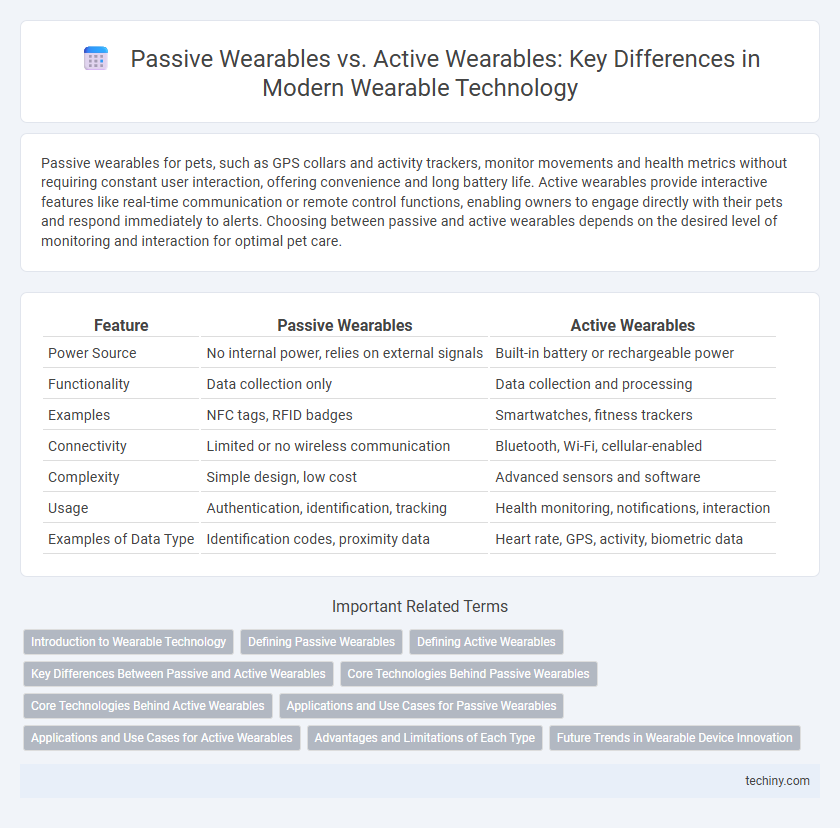Passive wearables for pets, such as GPS collars and activity trackers, monitor movements and health metrics without requiring constant user interaction, offering convenience and long battery life. Active wearables provide interactive features like real-time communication or remote control functions, enabling owners to engage directly with their pets and respond immediately to alerts. Choosing between passive and active wearables depends on the desired level of monitoring and interaction for optimal pet care.
Table of Comparison
| Feature | Passive Wearables | Active Wearables |
|---|---|---|
| Power Source | No internal power, relies on external signals | Built-in battery or rechargeable power |
| Functionality | Data collection only | Data collection and processing |
| Examples | NFC tags, RFID badges | Smartwatches, fitness trackers |
| Connectivity | Limited or no wireless communication | Bluetooth, Wi-Fi, cellular-enabled |
| Complexity | Simple design, low cost | Advanced sensors and software |
| Usage | Authentication, identification, tracking | Health monitoring, notifications, interaction |
| Examples of Data Type | Identification codes, proximity data | Heart rate, GPS, activity, biometric data |
Introduction to Wearable Technology
Wearable technology encompasses devices categorized into passive wearables, like fitness trackers that monitor health metrics without user interaction, and active wearables, such as smartwatches offering interactive features and real-time feedback. Passive wearables primarily collect data continuously, optimizing health tracking and lifestyle analysis. Active wearables integrate sensors with computing capabilities to enable notifications, apps, and user input, enhancing connectivity and personalized experiences.
Defining Passive Wearables
Passive wearables are devices that collect data without requiring user input or actively influencing the environment, such as fitness trackers monitoring heart rate or sleep patterns. These wearables rely on sensors to passively gather biometric and behavioral information for health and activity analysis. Examples include smart rings, wristbands, and patches that enable continuous health monitoring with minimal user engagement.
Defining Active Wearables
Active wearables are electronic devices equipped with sensors and processors that continuously collect, analyze, and transmit data in real-time, enhancing user interaction and functionality. Unlike passive wearables, active wearables include features like heart rate monitoring, GPS tracking, and activity recognition, offering dynamic health and fitness insights. These devices often connect to smartphones or cloud platforms for advanced data processing and personalized feedback.
Key Differences Between Passive and Active Wearables
Passive wearables primarily function by monitoring and collecting health data such as heart rate, sleep patterns, and physical activity without requiring user intervention. Active wearables, on the other hand, engage users through real-time feedback, exercise guidance, or interactive features, often incorporating sensors and processors to analyze data on the spot. Key differences include passive wearables' focus on passive data tracking versus active wearables' capability to prompt behavioral changes and deliver personalized coaching.
Core Technologies Behind Passive Wearables
Passive wearables operate without batteries, relying on energy harvested from the environment such as radio frequency (RF) signals, body heat, or motion. Core technologies include near-field communication (NFC) chips and piezoelectric materials that convert mechanical stress into electrical energy. These innovations enable lightweight, maintenance-free devices that continuously monitor health metrics or enable contactless payments without active power sources.
Core Technologies Behind Active Wearables
Active wearables rely on core technologies such as sensors, microprocessors, and wireless communication modules that enable real-time data collection, processing, and transmission. Advanced biometric sensors measure heart rate, motion, and physiological signals, while embedded processors analyze this data to deliver immediate feedback and personalized insights. Integration of Bluetooth and Wi-Fi modules ensures seamless connectivity with smartphones and cloud platforms for continuous monitoring and data synchronization.
Applications and Use Cases for Passive Wearables
Passive wearables, such as RFID tags and smart clothing, excel in applications like inventory management, asset tracking, and health monitoring without the need for batteries or active power sources. These devices often capture environmental or physiological data passively, making them ideal for long-term monitoring in supply chains and medical diagnostics. Common use cases include monitoring patient vitals in hospitals, improving retail stock accuracy, and tracking equipment usage in manufacturing environments.
Applications and Use Cases for Active Wearables
Active wearables, equipped with sensors and processing capabilities, enable real-time health monitoring, fitness tracking, and personalized coaching by continuously collecting and analyzing biometric data. Applications extend to medical diagnostics, such as glucose monitoring for diabetics, and rehabilitation therapy through adaptive feedback systems. These devices support dynamic user interaction and offer advanced functionalities beyond passive data collection, enhancing user engagement and outcome optimization.
Advantages and Limitations of Each Type
Passive wearables offer advantages such as longer battery life and reduced maintenance due to their reliance on external power sources or energy harvesting, making them ideal for continuous health monitoring without frequent charging. However, their limitations include limited functionality and dependence on external signals, which can affect data accuracy and consistency. Active wearables provide advanced features like real-time data processing and interactive feedback through integrated sensors and processors, but they often suffer from shorter battery life and require regular charging, posing challenges for extended use.
Future Trends in Wearable Device Innovation
Passive wearables, such as fitness trackers that monitor biometric data without active user input, are evolving with enhanced sensor accuracy and energy-efficient components. Active wearables, including smartwatches and augmented reality glasses, are driving innovation through integration of AI-powered features and real-time health analytics. Future trends emphasize seamless connectivity, biometric data fusion, and adaptive interfaces tailored to personalized user experiences in both passive and active wearable devices.
Passive Wearables vs Active Wearables Infographic

 techiny.com
techiny.com